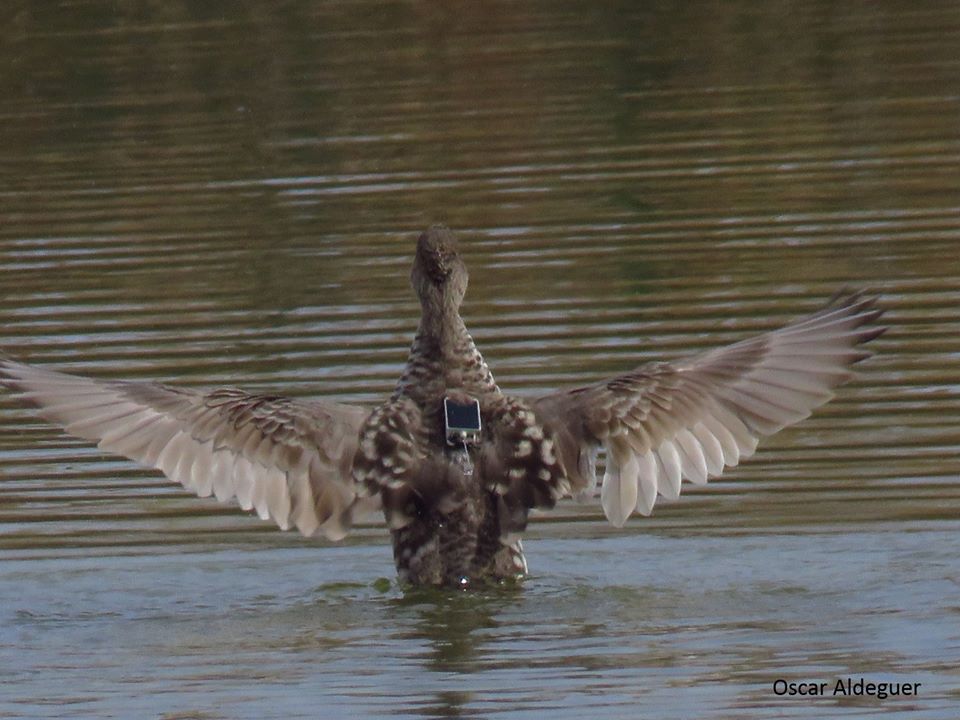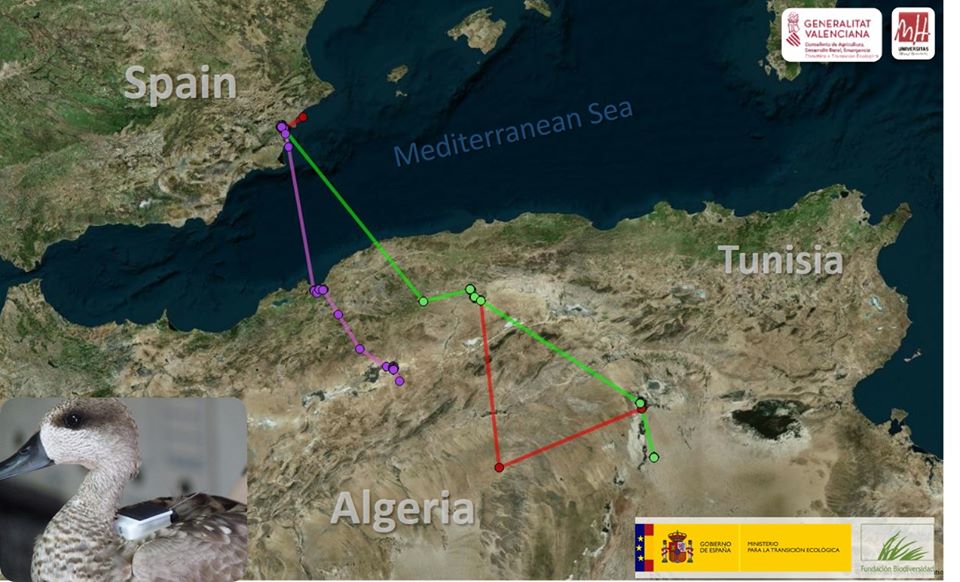A total of 27 Marbled Ducks were satellite-tracked in south-east Spain, of these only three have survived by migrating to Algeria. Most of the birds that stayed locally were shot dead or are missing.

The most threatened duck in Europe
With a decreasing population, the Marbled Duck (Marmaronetta angustirostris) is classed globally as ‘Vulnerable’ in the IUCN Red List of Threatened Species. In Spain, where the population is very small, the species is categorised as ‘Endangered’ in the National Catalogue of Endangered Species (Royal Decree 139/2011) and ‘Critically Endangered’ in the Red Book of Birds of Spain (Green et al. 2004).
In 2018, the Marbled Duck population in Spain was composed of between 68 and 71 breeding pairs located in 13 wetlands (Ministerio para la Transición Ecológica, 2019). The largest number of breeding females were recorded in four areas: Doñana (16 breeding females), the marshes of Trebujena in Cádiz (12), Natural Park of El Hondo in Alicante (6) and S’Albufera Natural Park in the Balearic Islands (between 4 and 6).
The conservation of the species in Spain is of high priority, and a number of projects have been initiated in order to avoid the extinction of the species.
Population reinforcement at El Hondo
One of these projects is the population reinforcement (restocking) at the Natural Park of El Hondo in the Valencian Community. Marbled Ducks were raised in captivity and then released at El Hondo using the hacking technique (‘hacking’ is an old method first developed and used in falconry and now applied in reintroduction projects of many endangered species). The released birds were fitted with GPS transmitters to track their movements.
The monitoring project is carried out by the Ecology Research Group at Miguel Hernández University of Elche in collaboration with the Generalitat Valenciana (the regional government), and is financed by the Ministry for Ecological Transition (of the central government) through the Fundación Biodiversidad.
Between 2018 and 2019, the project team marked a total of 27 Marbled Ducks. Among these, 25 birds were successfully released at El Hondo.
In December 2019, only three birds have managed to survive by crossing the Mediterranean Sea to Algeria (two of them reached Algeria in late September). The birds that stayed in Spain are dead or missing. The causes of death are the following:
- Collision with power line (1 bird),
- Predation (2 birds confirmed + 1 probable)
- Hunting (4 birds confirmed + 8 probable). The shooting of the four confirmed birds took place in a game reserves inside El Hondo.
- Unknown causes (6 birds).
Because the Marbled Duck is not a huntable species in Spain, so the killed birds were either mistaken with other duck species that are legally hunted or deliberately shot (= outright illegal hunting).
If you read this until the end then you understand that the three birds haven’t literally escaped the guns. Included this in the title to emphasize the fact that hunting was indeed the main cause of mortality for this population. As we know, the species is a partial migrant (meaning that only a part of the population migrates whereas the rest stay locally year around) and Spanish Marbled Ducks are known to winter in North Africa.

References
Green, A.J. Echevarría, J.L. & Ferrández, M. 2004. Cerceta pardilla Marmaronetta angustirostris. In: Madroño, A. González, C. & Atienza, J.C. (Eds.). Libro Rojo de las Aves de España. Dirección General para la Biodiversidad-SEO/BirdLife. Madrid.
Ministerio para la Transición Ecológica, 2019. El grupo de trabajo de la Cerceta pardilla acuerda nuevas acciones de conservación para abordar el elevado riesgo de extinción de la especie. Fundación Biodiversidad, published 3 April 2019.
What chance of long term survival has the species got when intense hunting pressure takes place inside protected areas ? It begs belief that a vulnerable species can be under so much hunting pressure from within the EU. It would be a good start to make all registered hunters within the EU to take a wildfowl identification test when they apply for a shotgun certificate.
Its just a waste of money to establish protected areas when once birds leave the confines of a protected site they are blown out of the sky.
Marbled ducks in a National Park in Spain, hen harriers on grouse moors in the UK. The answer is to ban shooting. No-one is going to starve if they can’t hunt ducks or kill raptors take take game birds that only exist because they are bred to be shot for money.
The vast majority of hunters can’t identify what they’re shooting unless you go to basics such as goose, duck or self in the foot.
The Guidance Document of Birds Directive at paragraphs 2.6.10. 2.6.12, 2.6.13 state that education and training of hunters are solutions. Hunting bans are not useful because take away hunters from habitat management.